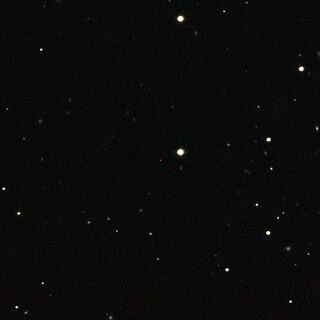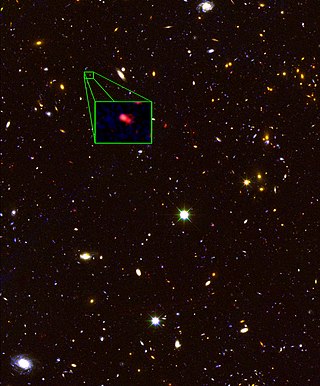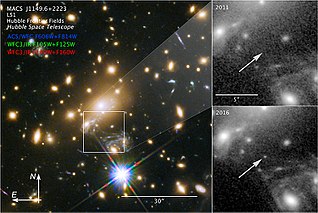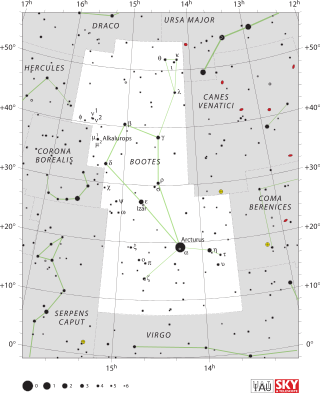
A quasar is an extremely luminous active galactic nucleus (AGN). It is sometimes known as a quasi-stellar object, abbreviated QSO. The emission from an AGN is powered by a supermassive black hole with a mass ranging from millions to tens of billions of solar masses, surrounded by a gaseous accretion disc. Gas in the disc falling towards the black hole heats up and releases energy in the form of electromagnetic radiation. The radiant energy of quasars is enormous; the most powerful quasars have luminosities thousands of times greater than that of a galaxy such as the Milky Way. Quasars are usually categorized as a subclass of the more general category of AGN. The redshifts of quasars are of cosmological origin.

In physics, a redshift is an increase in the wavelength, and corresponding decrease in the frequency and photon energy, of electromagnetic radiation. The opposite change, a decrease in wavelength and increase in frequency and energy, is known as a blueshift, or negative redshift. The terms derive from the colours red and blue which form the extremes of the visible light spectrum. The main causes of electromagnetic redshift in astronomy and cosmology are the relative motions of radiation sources, which give rise to the relativistic Doppler effect, and gravitational potentials, which gravitationally redshift escaping radiation. All sufficiently distant light sources show cosmological redshift corresponding to recession speeds proportional to their distances from Earth, a fact known as Hubble's law that implies the universe is expanding.
The following is a timeline of galaxies, clusters of galaxies, and large-scale structure of the universe.

The observable universe is a ball-shaped region of the universe comprising all matter that can be observed from Earth or its space-based telescopes and exploratory probes at the present time; the electromagnetic radiation from these objects has had time to reach the Solar System and Earth since the beginning of the cosmological expansion. Initially, it was estimated that there may be 2 trillion galaxies in the observable universe. That number was reduced in 2021 to only several hundred billion based on data from New Horizons. Assuming the universe is isotropic, the distance to the edge of the observable universe is roughly the same in every direction. That is, the observable universe is a spherical region centered on the observer. Every location in the universe has its own observable universe, which may or may not overlap with the one centered on Earth.

APM 08279+5255 is a very distant, broad absorption line quasar located in the constellation Lynx. It is magnified and split into multiple images by the gravitational lensing effect of a foreground galaxy through which its light passes. It appears to be a giant elliptical galaxy with a supermassive black hole and associated accretion disk. It possesses large regions of hot dust and molecular gas, as well as regions with starburst activity.

GRB 090423 was a gamma-ray burst (GRB) detected by the Swift Gamma-Ray Burst Mission on April 23, 2009 at 07:55:19 UTC whose afterglow was detected in the infrared and enabled astronomers to determine that its redshift is z = 8.2, which makes it one of the most distant objects detected to date with a spectroscopic redshift.

UDFy-38135539 is the Hubble Ultra Deep Field (UDF) identifier for a galaxy which was calculated as of October 2010 to have a light travel time of 13.1 billion years with a present proper distance of around 30 billion light-years.

ULAS J1120+0641 was the most distant known quasar when discovered in 2011, surpassed in 2017 by ULAS J1342+0928. ULAS J1120+0641 was the first quasar discovered beyond a redshift of z = 7. Its discovery was reported in June 2011.

MACS0647-JD is a galaxy with a redshift of about z = 10.7, equivalent to a light travel distance of 13.26 billion light-years. If the distance estimate is correct, it formed about 427 million years after the Big Bang.

z8_GND_5296 is a dwarf galaxy discovered in October 2013 which has the highest redshift that has been confirmed through the Lyman-alpha emission line of hydrogen, placing it among the oldest and most distant known galaxies at approximately 13.1 billion light-years (4.0 Gpc) from Earth. It is "seen as it was at a time just 700 million years after the Big Bang [...] when the universe was only about 5 percent of its current age of 13.8 billion years". The galaxy is at a redshift of 7.51, and it is a neighbour to what was announced then as the second-most distant galaxy with a redshift of 7.2. The galaxy in its observable timeframe was producing stars at a phenomenal rate, equivalent in mass to about 330 Suns per year.

EGS-zs8-1 is a high-redshift Lyman-break galaxy found at the northern constellation of Boötes. In May 2015, EGS-zs8-1 had the highest spectroscopic redshift of any known galaxy, meaning EGS-zs8-1 was the most distant and the oldest galaxy observed. In July 2015, EGS-zs8-1 was surpassed by EGSY8p7 (EGSY-2008532660).

GN-z11 is a high-redshift galaxy found in the constellation Ursa Major. It is among the farthest known galaxies from Earth ever discovered. The 2015 discovery was published in a 2016 paper headed by Pascal Oesch and Gabriel Brammer. Up until the discovery of JADES-GS-z13-0 in 2022 by the James Webb Space Telescope, GN-z11 was the oldest and most distant known galaxy yet identified in the observable universe, having a spectroscopic redshift of z = 10.957, which corresponds to a proper distance of approximately 32 billion light-years.

TON 618 is a hyperluminous, broad-absorption-line, radio-loud quasar and Lyman-alpha blob located near the border of the constellations Canes Venatici and Coma Berenices, with the projected comoving distance of approximately 18.2 billion light-years from Earth. It possesses one of the most massive black holes ever found, at 40.7 billion M☉.

ULAS J1342+0928 is the second-most distant known quasar detected and contains the second-most distant and oldest known supermassive black hole, at a reported redshift of z = 7.54. The ULAS J1342+0928 quasar is located in the Boötes constellation. The related supermassive black hole is reported to be "800 million times the mass of the Sun".

MACS J1149 Lensed Star 1, also known as Icarus, is a blue supergiant star observed through a gravitational lens. It is the seventh most distant individual star to have been detected so far, at approximately 14 billion light-years from Earth. Light from the star was emitted 4.4 billion years after the Big Bang. According to co-discoverer Patrick Kelly, the star is at least a hundred times more distant than the next-farthest non-supernova star observed, SDSS J1229+1122, and is the first magnified individual star seen.

WHL0137-LS, also known as Earendel, is a star in the constellation of Cetus. Discovered in 2022 by the Hubble Space Telescope, it is the earliest and most distant known star, at a comoving distance of 28 billion light-years. The previous furthest known star, MACS J1149 Lensed Star 1, also known as Icarus, at a comoving distance of 14.4 billion light-years, was discovered by Hubble in 2018. Stars like Earendel can be observed at cosmological distances thanks to the large magnification factors involved, that can exceed 1000. Other stars have been observed through this technique, such as Godzilla.

GLASS-z12 is a Lyman-break galaxy discovered by the Grism Lens-Amplified Survey from Space (GLASS) observing program using the James Webb Space Telescope's NIRCam in July 2022. Spectroscopic observations of GLASS-z12 by the Atacama Large Millimeter Array (ALMA) in August 2022 confirmed that the galaxy has a spectroscopic redshift of 12.117±0.012, making it one of the earliest and most distant galaxies ever discovered, dating back to just 350 million years after the Big Bang, 13.6 billion years ago. ALMA observations detected an emission line associated with doubly ionized oxygen at 258.7 GHz with a significance of 5σ, suggesting that there is very low dust content in GLASS-z12, if not the early universe as well. Also based on oxygen-related measurements, the age of the galaxy is confirmed.

CEERS-93316 is a high-redshift galaxy with a spectroscopic redshift z=4.9. Significantly, the redshift that was initially reported was photometric and would have made CEERS-93316 the earliest and most distant known galaxy observed.
F200DB-045 is a candidate high-redshift galaxy, with an estimated redshift of approximately z = 20.4, corresponding to 168 million years after the Big Bang. If confirmed, it would be one of the earliest and most distant known galaxies observed.

![An early galaxy candidate (at z=13.3) and the History of the Universe (logarithmic scale; (7 April 2022)
[Compare: Nature timeline - History of the Universe (linear scale)] EarliestGalaxyCandidates-20220407.jpg](http://upload.wikimedia.org/wikipedia/commons/thumb/1/13/EarliestGalaxyCandidates-20220407.jpg/700px-EarliestGalaxyCandidates-20220407.jpg)
















